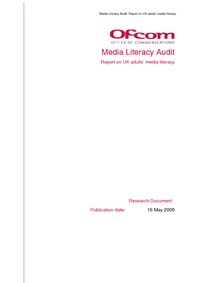Media Literacy AuditReport on UK adults’ media literacy
|

|
 Diese Seite wurde seit 2 Jahren inhaltlich nicht mehr aktualisiert.
Unter Umständen ist sie nicht mehr aktuell.
Diese Seite wurde seit 2 Jahren inhaltlich nicht mehr aktualisiert.
Unter Umständen ist sie nicht mehr aktuell.
 Zusammenfassungen
Zusammenfassungen
 The promotion of media literacy is a responsibility placed on Ofcom by Section 11 of the Communications Act 2003. Ofcom’s definition of media literacy, developed after formal consultation with stakeholders, is “the ability to access, understand and create communications in a variety of contexts”. This report is structured according to the elements in this definition:
The promotion of media literacy is a responsibility placed on Ofcom by Section 11 of the Communications Act 2003. Ofcom’s definition of media literacy, developed after formal consultation with stakeholders, is “the ability to access, understand and create communications in a variety of contexts”. This report is structured according to the elements in this definition:Access includes take-up of media devices, volume and breadth of use.
Understand includes interest and competence in using the features available on each platform, extent and levels of concern about content, trust in internet sites, trust in news, and knowledge of regulation and funding sources.
Create includes people’sconfidence in engaging with creative content, and their interest in carrying out creative tasks, notably using social networking sites.
While almost everyone engages with the media to some degree, the extent of media literacy varies across the population, and this variation is apparent across each of the three elements of media literacy outlined above. We have found that age and socio-economic group play a pivotal role in the extent of a person’s media literacy.
Use of media technologies by people under 55 years old continues to grow. In particular, 16-24 year olds are at the forefront of using, and getting the most out of media devices, in terms of in-home access, the way they use media, and their confidence in using the various devices. Households containing children, and those in socio-economic groups AB and C1, are also more likely to use media.
In contrast, older people, generally those over 65, and people who are in the C2DE socio-economic groups tend to be less involved with media than others in the population.
The extent of media literacy also depends on people’s media understanding; whether they understand the influences on the content they consume, whether they evaluate what they see and hear, and whether they are concerned about any aspects of the multimedia world in which they live.
Our research findings in this area suggest that younger people’s enthusiastic take-up of new media and their technical skills are not necessarily complemented by a good understanding of the ways in which media content is funded and regulated. Similarly, their confidence in using the internet may mean that they are not necessarily exercising appropriate critical thinking or care when using websites. This might expose them to unsuitable material or to other risks, such as those relating to the security of their personal information. Their confidence may be a consequence of their insufficient awareness of the potential risks associated with internet use.
Older people and C2DEs (particularly DEs) use fewer functions and are less likely to be confident in using a range of media platforms, notably the internet. They are more likely to be concerned about what is on the internet and television, and their concerns are limiting the way they use websites. Confidence (or lack of it) is also playing a part. Compared with the general population, over-65s are less likely to use new websites, or to critically evaluate the new websites they do use. They are also less likely to be willing to share their personal details in order to access websites, and are less likely to seek learning support to overcome their concerns.
Carrying out creative tasks online generally requires more sophisticated skills than simply finding information, which people are more confident about.
Social networking sites are an example of a creative activity on the internet. One in five internet users say they have a profile on a social networking site. People tend to use them for a range of activities, although the main one is communicating with people they know.
 Dieses Buch erwähnt ...
Dieses Buch erwähnt ...
 Zitationsgraph (Beta-Test mit vis.js)
Zitationsgraph (Beta-Test mit vis.js)
 1 Erwähnungen
1 Erwähnungen 
- Medienpädagogik - Ein Studienbuch zur Einführung (Daniel Süss, Claudia Lampert, Christine Wijnen) (2009)

 Volltext dieses Dokuments
Volltext dieses Dokuments
 |  Media Literacy Audit: Gesamtes Buch als Volltext ( Media Literacy Audit: Gesamtes Buch als Volltext ( : :  , 620 kByte; , 620 kByte;  : :  Link unterbrochen? Letzte Überprüfung: 2020-11-28 Letzte erfolgreiche Überprüfung: 2011-11-13) Link unterbrochen? Letzte Überprüfung: 2020-11-28 Letzte erfolgreiche Überprüfung: 2011-11-13) |
 Anderswo suchen
Anderswo suchen 
 Beat und dieses Buch
Beat und dieses Buch
Beat hat dieses Buch während seiner Zeit am Institut für Medien und Schule (IMS) ins Biblionetz aufgenommen. Beat besitzt kein physisches, aber ein digitales Exemplar. Eine digitale Version ist auf dem Internet verfügbar (s.o.). Aufgrund der wenigen Einträge im Biblionetz scheint er es nicht wirklich gelesen zu haben. Es gibt bisher auch nur wenige Objekte im Biblionetz, die dieses Werk zitieren.











 Phishing
Phishing Biblionetz-History
Biblionetz-History